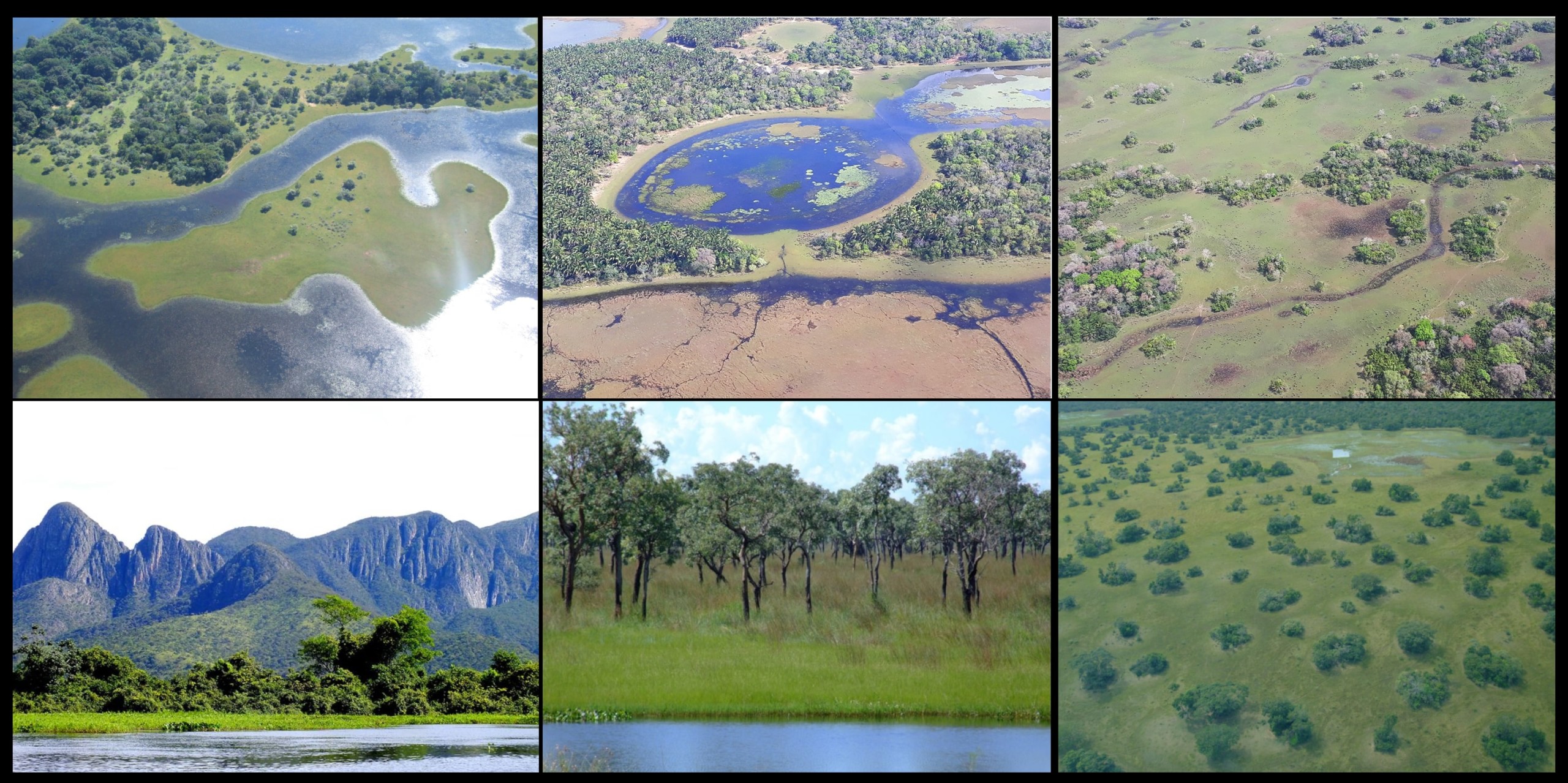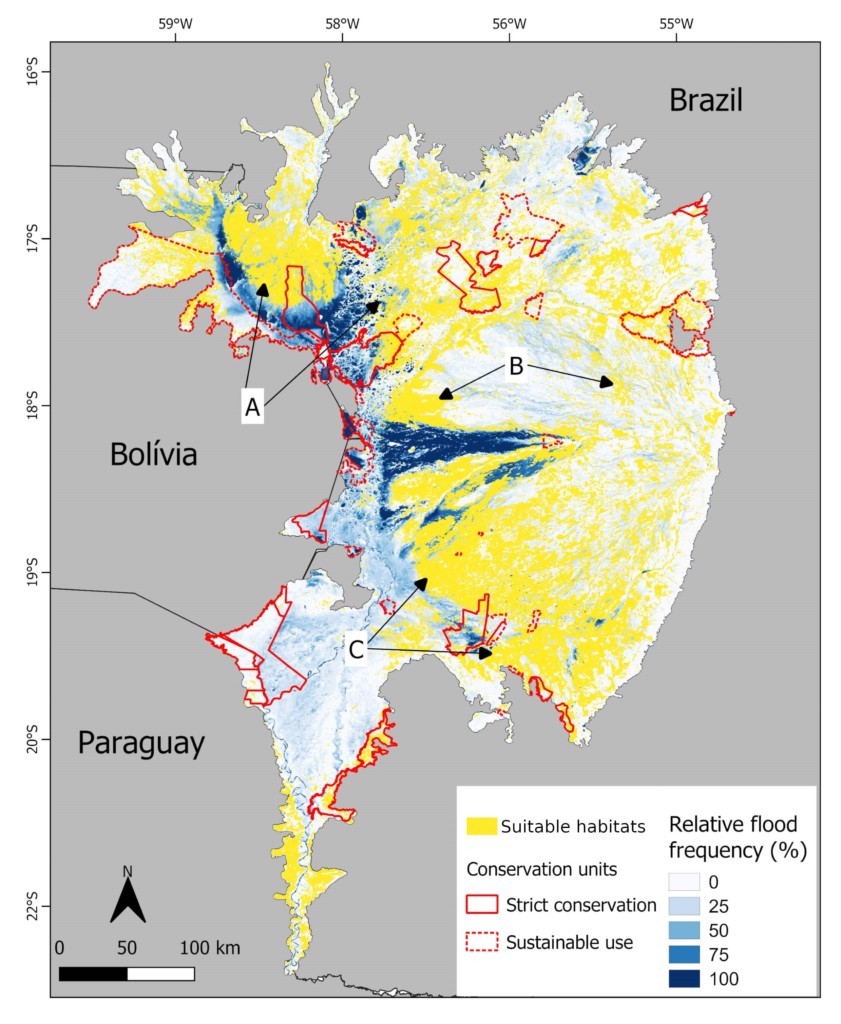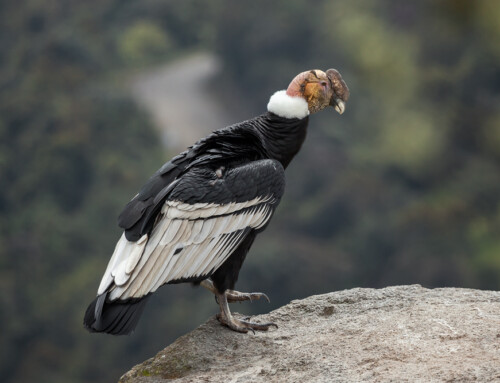LINKED PAPER
Lack of protected areas and future habitat loss threaten the Hyacinth Macaw Anodorhynchus hyacinthinus and its main food and nesting resources. Oliveira, M.R., Szabo, J.K., dos S. Júnior, A., Guedes, N.M.R., Tomas, W.M., Camilo, A.R., Padovane, C.R., Peterson, A.T., Garcia, L.C. 2021 IBIS. DOI: 10.1111/ibi.12982 VIEW
 The Hyacinth Macaw (Anodorhynchus hyacinthinus) is a large, striking blue parrot with yellow markings on its face. Adults reach 1 m in length. In 2014, the species was downlisted to globally vulnerable from its previous (2000-2013) endangered status (BirdLife International 2016). While some of its characteristics, such as monogamy, low recruitment rates and being a specialist make it more threatened, the over 80% decline was primarily caused by habitat loss, hunting and illegal take for the pet market (BirdLife International 2016). Protected areas are one of the main strategies to mitigate the effects of habitat loss and subsequent population decline for the Hyacinth Macaw.
The Hyacinth Macaw (Anodorhynchus hyacinthinus) is a large, striking blue parrot with yellow markings on its face. Adults reach 1 m in length. In 2014, the species was downlisted to globally vulnerable from its previous (2000-2013) endangered status (BirdLife International 2016). While some of its characteristics, such as monogamy, low recruitment rates and being a specialist make it more threatened, the over 80% decline was primarily caused by habitat loss, hunting and illegal take for the pet market (BirdLife International 2016). Protected areas are one of the main strategies to mitigate the effects of habitat loss and subsequent population decline for the Hyacinth Macaw.
Hyacinth Macaws mostly feed on the fruits of the medium-sized Acuri palm (Atallea phallerata) (Guedes 1993), common in woodlands all around western South America. Around 90% of macaw nests are in hollows of the large Manduvi tree (Sterculia apetala)(Guedes 1993), found from Central America to central South America. Both trees provide food and shelter to a variety of species from arthropods to large mammals. While the macaw also uses woodlands, its distribution is more restricted compared to these plants, with isolated populations in northern, north-eastern, and central western Brazil (Presti et al. 2015). This third population in the Pantanal holds about 70% of all individuals, which are the focus of our study (Presti et al. 2015). At about 150,000 km2, the Pantanal is the largest inland wetland in the world with a unique biodiversity. Water is a source of life in the Pantanal, with temporally and spatially variable floods resulting in dry-wet cycles. Variations in flooding patterns along with soil characteristics and other abiotic factors create highly heterogeneous habitats sometimes a few meters from each other.
 Figure 1 The striking Hyacinth Macaw (Anodorhynchus hyacinthinus) during its different life phases in the Pantanal. A) A pair of adults (photo credit: Luciano Candisani/Arquivo Instituto Arara-azul); B) Adult macaw feeding on the fruit of the Acuri palm (Atallea phallerata) (photo credit: Thamy Moreira); C) A breeding pair at the entrance of their nest hollow in the trunk of a Manduvi tree (Sterculia apetala) (photo credit: Fernanda Fontoura/Arquivo Instituto Arara-azul); D) Fledgling in a nest cavity (photo credit: Fernanda Fontoura/ Arquivo Instituto Arara-azul).
Figure 1 The striking Hyacinth Macaw (Anodorhynchus hyacinthinus) during its different life phases in the Pantanal. A) A pair of adults (photo credit: Luciano Candisani/Arquivo Instituto Arara-azul); B) Adult macaw feeding on the fruit of the Acuri palm (Atallea phallerata) (photo credit: Thamy Moreira); C) A breeding pair at the entrance of their nest hollow in the trunk of a Manduvi tree (Sterculia apetala) (photo credit: Fernanda Fontoura/Arquivo Instituto Arara-azul); D) Fledgling in a nest cavity (photo credit: Fernanda Fontoura/ Arquivo Instituto Arara-azul).
 Figure 2 Water is essential to life in the Pantanal (photo credit: Walfrido Tomas)
Figure 2 Water is essential to life in the Pantanal (photo credit: Walfrido Tomas)
Despite the uniqueness and high conservation value of this biome, 14.9% of the area originally covered by native vegetation had, by 2014, been converted into pastures for grazing (Roque et al. 2016). Furthermore, only 7% of the Pantanal is under strict protection, with an additional 4% under sustainable use, where natural resource management and human habitation are allowed (Tomas et al. 2019). Looking at the last 15 years, more native vegetation was converted into pastures than the area currently protected. High rates of land clearing and low representation in the protected area system are particularly affecting rarely-flooded forested areas containing Acuri and Manduvi trees preferred by the Hyacinth Macaw. On the other hand, frequently-flooded grasslands and savannas are overrepresented among protected areas. As Acuri and Manduvi cannot survive under frequent flooding, these areas are also unsuitable for the macaw. Historically, protected areas have been designated in areas that were considered worthless, on land of low value for agriculture or development. In the Pantanal, frequently-flooded areas have been cheaper to purchase for conservation purposes, as the costs of economic activities and maintaining dwellings are higher.
Our modelling showed that regions that lack Acuri and Manduvi can be considered geographical barriers for the Hyacinth Macaw, as the subpopulations in the south and the north of the Pantanal are genetically different. We identified areas that could serve as natural corridors connecting these two populations. Unfortunately, the native vegetation in these possible corridors has already been lost or is at high risk of being converted into pastures in the near future. This is very worrying, as the destruction of these corridors can lead to the complete isolation of the two macaw subpopulations. We also highlighted areas that would be of high interest for restoration to conserve the macaws.
 Figure 3 Remnants of suitable habitat predicted for Acuri Palm, Manduvi Tree and Hyacinth Macaw, with flood frequency and protected areas (solid border for strict conservation and dashed border for areas of sustainable use) in the Pantanal biome. A: Cluster of suitable areas in the north; B: Suitable areas that could potentially connect northern and southern Hyacinth Macaw subpopulations; C: Cluster of suitable areas in the south.
Figure 3 Remnants of suitable habitat predicted for Acuri Palm, Manduvi Tree and Hyacinth Macaw, with flood frequency and protected areas (solid border for strict conservation and dashed border for areas of sustainable use) in the Pantanal biome. A: Cluster of suitable areas in the north; B: Suitable areas that could potentially connect northern and southern Hyacinth Macaw subpopulations; C: Cluster of suitable areas in the south.
It is important to emphasize that the study that gave rise to the article was carried out with the contribution of the Instituto Arara Azul and the Empresa Brasileira de Pesquisa Agropecuaria (Embrapa-Pantanal), which are two important research institutions in the Pantanal.
References
BirdLife International. 2016. Anodorhynchus hyacinthinus. The IUCN Red List of Threatened Species. 2016: e.T22685516A93077457. VIEW
Guedes, N.M.R. 1993. Biologia Reprodutiva da Arara Azul no Pantanal Sul-Matogrossense. (Masters Thesis) Escola superior de Agricultura “Luiz de Queiroz”
Presti, F.T., Guedes, N.M.R., Antas, P.T.Z. & Miyaki, C.Y. 2015. Population genetic structure in hyacinth macaws (Anodorhynchus hyacinthinus) and identification of the probable origin of confiscated individuals. Journal of Heredity 106: 491–502. VIEW
Roque, F.O., Ochoa-Quintero, J., Ribeiro, D.B., Sugai, L.S.M., Costa-Pereira, R., Lourival, R. & Bino, G. 2016. Upland habitat loss as a threat to Pantanal wetlands. Conservation Biology 30: 1131–1134. VIEW
Tomas, W.M., de Oliveira Roque, F., Morato, R.G., Medici, P.E., Chiaravalloti, R.M., Tortato, F.R. et al. 2019. Sustainability Agenda for the Pantanal Wetland: Perspectives on a Collaborative Interface for Science, Policy, and Decision-Making. Tropical Conservation Science 12: 1-30. VIEW
Image credit
Top right: Hyacinth Macaw (Anodorhynchus hyacinthinus) in a nest in Manduvi tree (Sterculia apetala) © Cézar Corrêa/Arquivo Instituto Arara-azul




